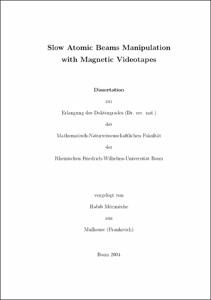Mérimèche, Habib: Slow Atomic Beams Manipulation with Magnetic Videotapes. - Bonn, 2004. - Dissertation, Rheinische Friedrich-Wilhelms-Universität Bonn.
Online-Ausgabe in bonndoc: https://nbn-resolving.org/urn:nbn:de:hbz:5n-03352
Online-Ausgabe in bonndoc: https://nbn-resolving.org/urn:nbn:de:hbz:5n-03352
@phdthesis{handle:20.500.11811/2025,
urn: https://nbn-resolving.org/urn:nbn:de:hbz:5n-03352,
author = {{Habib Mérimèche}},
title = {Slow Atomic Beams Manipulation with Magnetic Videotapes},
school = {Rheinische Friedrich-Wilhelms-Universität Bonn},
year = 2004,
note = {Laser cooling methods provide the possibility to obtain very well collimated and slow atomic beams. These intense sources have attracted new interest in the manipulation of atomic trajectories. Atom optical schemes based on the optical dipole force are very attractive, for example in atom lithography where atomic beams are focused by standing wave light elds, to create periodic nanostructures. However, in applications where more complex structures are desirable or decoherence due to spontaneous emission has to be avoided, magnetic atom optical components are more attractive.
For example, at and curved atomic mirrors with high reflectivity and low surface rough ness can be built from periodically magnetized videotapes.
First, with a collimated and polarized cesium atomic beam from a Zeeman-slower apparatus, we have investigated the deflection of the atomic beam by a sinusoidally magnetized videotape with a period length of 30 μm. From these measurements we have determined the magnetic eld strength at the surface to be 0.05 Tesla. The reflectivity has been found to be consistent with 100%. The very large eld gradients produced by the tape can be exploited to guide atoms on curved trajectories with small radii of curvature. With a radius of 9.5 cm we have obtained a maximum deflection angle of 25° which is limited by technical constraint.
Second, we have built a setup based on a 2D-MOT for generating a slow atomic beam with a velocity of 20 m/s. After leaving the optical collimation and the optical polarization stages, the atomic beam is reflected after one bounce onto the videotape up to angles as large as 7°. We exploited the natural curvature of our videotape and we demonstrated the focusing of the atomic beam after one and two bounces depending on the curvature of the videotape. The focal length and the angles of deflection enable to deduce the local radii of curvature. We have confronted our results by testing the focusing of the videotape with a red laser and by performing a numerical simulation which prove the consistency with the atomic beam experiments.},
url = {https://hdl.handle.net/20.500.11811/2025}
}
urn: https://nbn-resolving.org/urn:nbn:de:hbz:5n-03352,
author = {{Habib Mérimèche}},
title = {Slow Atomic Beams Manipulation with Magnetic Videotapes},
school = {Rheinische Friedrich-Wilhelms-Universität Bonn},
year = 2004,
note = {Laser cooling methods provide the possibility to obtain very well collimated and slow atomic beams. These intense sources have attracted new interest in the manipulation of atomic trajectories. Atom optical schemes based on the optical dipole force are very attractive, for example in atom lithography where atomic beams are focused by standing wave light elds, to create periodic nanostructures. However, in applications where more complex structures are desirable or decoherence due to spontaneous emission has to be avoided, magnetic atom optical components are more attractive.
For example, at and curved atomic mirrors with high reflectivity and low surface rough ness can be built from periodically magnetized videotapes.
First, with a collimated and polarized cesium atomic beam from a Zeeman-slower apparatus, we have investigated the deflection of the atomic beam by a sinusoidally magnetized videotape with a period length of 30 μm. From these measurements we have determined the magnetic eld strength at the surface to be 0.05 Tesla. The reflectivity has been found to be consistent with 100%. The very large eld gradients produced by the tape can be exploited to guide atoms on curved trajectories with small radii of curvature. With a radius of 9.5 cm we have obtained a maximum deflection angle of 25° which is limited by technical constraint.
Second, we have built a setup based on a 2D-MOT for generating a slow atomic beam with a velocity of 20 m/s. After leaving the optical collimation and the optical polarization stages, the atomic beam is reflected after one bounce onto the videotape up to angles as large as 7°. We exploited the natural curvature of our videotape and we demonstrated the focusing of the atomic beam after one and two bounces depending on the curvature of the videotape. The focal length and the angles of deflection enable to deduce the local radii of curvature. We have confronted our results by testing the focusing of the videotape with a red laser and by performing a numerical simulation which prove the consistency with the atomic beam experiments.},
url = {https://hdl.handle.net/20.500.11811/2025}
}






